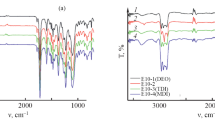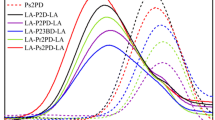Abstract
Synthesis of polyester thermoelastoplasts, block copolymers of polyoxytetramethylene glycol and poly(butylene terephthalate) of the polyblock type, was developed and implemented in pilot industrial conditions. POTM blocks act as flexible molecular decouplings that give the copolymer elasticity, while PBT blocks form physical linkages and are responsible for the mechanical strength and hardness of the material. The composition of the reaction systems, process stage sequence, and synthesis parameters are optimized for block copolymers with a concentration of the flexible POTM block of 65-10 wt. % and a molecular weight of 1000. The structure is investigated, and the physicochemical and mechanical properties of the material obtained are determined. It was found that the concentration of flexible blocks has a determining effect on the physicochemical structure and properties of the block copolymers. For a ∼40% concentration of the flexible block, the character of the concentration curves of the physicomechanical indexes changes significantly due to phase-structural transformations in the block copolymers.
Similar content being viewed by others
REFERENCES
N. R. Legge, G. Holden, and H. E. Schroeder (eds.), Thermoplastic Elastomers, Hanser Publishers, Vienna-New York (1997).
P. M. Valetskii and I. P. Storozhuk, Usp. Khim., 48,No. 1, 75–114 (199).
F. G. Gallagher, C. J. Hamilton, and R. F. Tietz, US Patent No. 5,097,004 (1992).
F. G. Gallagher, C. J. Hamilton, et al., WO 93/07197 (1993).
S. J. McCarthy, G. F. Meiys, and P. Gunatillake, J. Appl. Polym. Sci., 65,No. 7, 1319–1332 (1997).
O. Sangen, H. Yamasaki, et al., Kobunshi Ronbunshu, 52,No. 7, 402–409 (1995).
Shi Yh and Mu My, Polym. Int., 38,No. 4, 357–362 (1995).
C. M. Boussias, R. H. Peters, and R. H. Still, J. Appl. Polym. Sci., 25, 855–867 (1980).
J. C. Stevenson and S. L. Cooper, J. Polym. Sci., 26, Part B, 953 (1988).
M. I. Siling and T. I. Laricheva, Usp. Khim., 65,No. 3, 296–303 (1996).
S. S. Pesetskii, B. Jurkowski, et al., Eur. Polym. J., 37, 2187–2199 (2001).
I. N. Zhmykhov, Yu. M. Mozheiko, et al., RB Patent Application No. A-19990008 (1.5.1999).
S. S. Pesetskii, I. P. Storozhuk, et al., in: Proceedings of the International Scientific and Technical Conference “Polymer Composites-98” [in Russian], Gomel' (September 29–30, 1998), pp. 113–115.
G. K. Hoeschele, Angew. Makromol. Chem., 58/59, 299 (1977).
G. M. Bartenev, Structure and Relaxation Properties of Elastomers [in Russian], Khimiya, Moscow (1999).
B. M. Kovarskaya, A. B. Blyumenfel'd, and I. N. Levantovskaya, Thermal Stability of Heterochain Polymers [in Russian], Khimiya, Moscow (1977).
Author information
Authors and Affiliations
Rights and permissions
About this article
Cite this article
Mozheiko, Y.M. Properties of Block Copolymers of Poly(Butylene Terephthalate) and Polyoxytetramethylene Glycol. Fibre Chemistry 34, 254–259 (2002). https://doi.org/10.1023/A:1021040914415
Issue Date:
DOI: https://doi.org/10.1023/A:1021040914415




